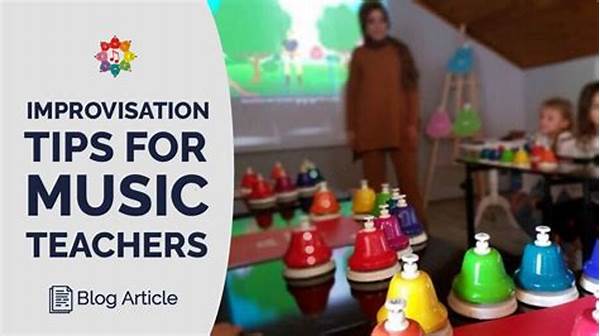It was a crisp autumn afternoon as Mr. Harmon, a seasoned music teacher with a passion for jazz, entered Room 204, his classroom sanctuary where melodies and harmonies collided. Typing the notes on the board, his mind wandered back to a time when a young student had asked, “How can we play music that’s not written on paper?” The question, though simple, was profound. Thus began Harmon’s journey into the world of musical improvisation, where creativity soared on spontaneous wings.
Read Now : Organized Theater Event Timelines
The Art of Spontaneity
Mr. Harmon was a man who lived in the moment, and he wanted his students to do the same, to feel the pulse of music and the excitement of the unknown. Drawing from countless books, workshops, and his own experiences, he developed improvisation techniques for music teachers who, like him, wanted to challenge the status quo. His classes became an exploration of sound, a dance between structure and chaos. Students learned to trust their instincts, to find their voice within the notes they played. They didn’t just learn music; they experienced it.
The changes within the classroom were palpable. Reserved students found confidence, and the more outspoken ones learned to listen, to attune to the subtle shifts in their peers’ music. Harmon’s improvisation techniques for music teachers were less about teaching notes and scales and more about teaching freedom. He encouraged curiosity and cultivated a safe space where making mistakes was celebrated as part of the creative journey. Each lesson was an adventure, an opportunity to discover something wholly unexpected yet beautiful.
Techniques in Practice
1. Feeling the Rhythm: Mr. Harmon encouraged his students to master the art of improvisation by first internalizing the rhythm. By feeling the beat within their bodies, they crafted melodies that reflected their innermost emotions.
2. Call and Response: Harmon implemented this age-old technique to build musical conversations. Students learned to react creatively in the moment, developing a keen ear for the nuances of sound.
3. Storytelling Through Sound: Each note became a word, each phrase a sentence. Harmon taught students to narrate their stories through their instruments, embracing improvisation techniques for music teachers with authenticity.
4. Theme Variation: By taking a simple theme and transforming it, Harmon’s students explored infinite possibilities. They painted new landscapes with musical strokes, pushing the boundaries of traditional compositions.
5. Emotionally Driven Improvisation: Music is emotion in sound form, and Harmon emphasized this by encouraging students to play what they felt, letting it shape their improvisation and transform their music.
Creating a Musical Dialogue
Mr. Harmon understood music as a transcendent language, one that could communicate profound truths without uttering a single word. To his students, he imparted the wisdom of improvisation techniques for music teachers, a means to converse through melody and harmony. Guided by Harmon’s gentle encouragement, they began to perceive music as more than just sound; it became an expression of their unique selves.
Read Now : “best Audition Songs List”
The heart of improvisation was, for Harmon, like weaving a narrative. As students improvised, they learned to listen deeply—to themselves, their peers, and the music itself. The classroom became a stage for storytelling, each student exploring their musical identity. And through it all, Mr. Harmon fostered an environment where creativity blossomed, nurturing a connection that transcended traditional teaching methods. Together, they shaped a world where music was not bound by notes on paper but was a living, breathing testament to their collective imagination.
The Breakthrough Moment
One afternoon, young Sally timidly approached the piano, her fingers hesitant over the keys. Harmon had invited the class to improvise on a simple chord progression. With a deep breath, Sally began to play, the notes weaving a tapestry of sound that silenced the room. Harmon watched with pride as her confidence grew; she had found her voice, a triumph of his improvisation techniques for music teachers. The breakthrough moment had arrived, igniting a passion in Sally that would linger long after the last note faded away.
Nurturing a Creative Mindset
Harmon realized that teaching improvisation was also about nurturing a mindset. He encouraged curiosity, inviting students to explore their own creative potential beyond the confines of printed music. With each lesson, the students transformed, becoming more willing to take musical risks. Through practice of improvisation techniques for music teachers, the fear of the unknown began to dissolve, leaving only the eagerness to explore new musical horizons.
Building Trust in Musical Expression
Teaching was not just about imparting knowledge but empowering students to trust themselves and their artistic instincts. Harmon created an atmosphere of trust, showing that improvisation was less about perfection and more about expression. Improvisation techniques for music teachers revolutionized the classroom, making it a haven for innovation where every student’s contribution was valued.
A Lasting Impact
The orchestra was preparing for its final performance of the year, but this one would be different. Mr. Harmon’s students were set to debut an improvisational piece—handcrafted and unique to their talents. Harmon’s improvisation techniques for music teachers had planted seeds of creativity and confidence in the students, gifts that would accompany them long after their school days had ended. As the first notes rang out into the auditorium, Harmon knew the journey had been worthwhile. Music, no longer confined to the written page, had become a source of endless discovery and joy.
In Conclusion
Mr. Harmon’s story serves as a catalyst, encouraging educators everywhere to embrace improvisation techniques for music teachers as a path toward enriching their teaching practices. By integrating improvisation, teachers can unlock new dimensions of creativity and expression. Through this lens, music education transforms, fostering environments where inspiration thrives and students emerge as creators in their right. Their journey, like Mr. Harmon’s, becomes a tale of harmony, innovation, and the limitless possibilities found in the world of music.
